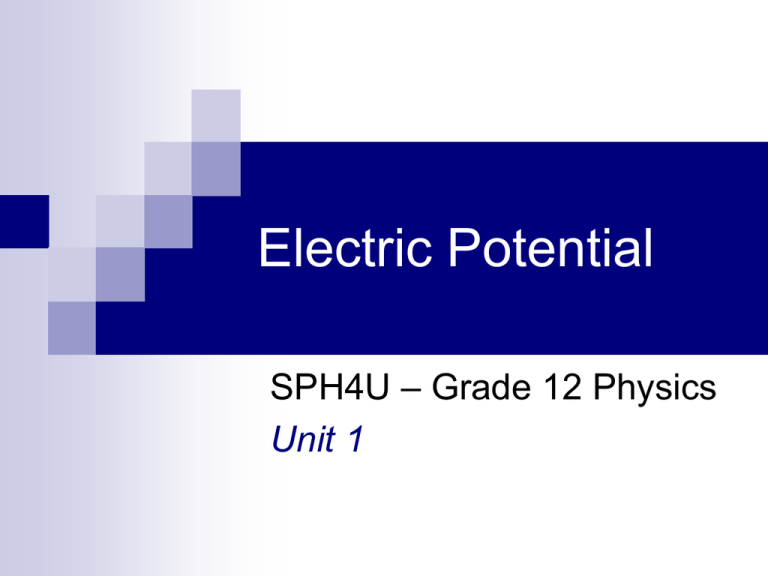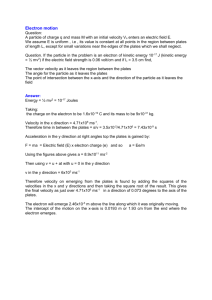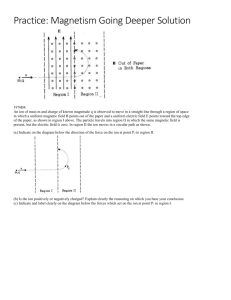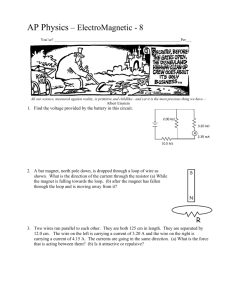Electric Potential - K
advertisement

Electric Potential SPH4U – Grade 12 Physics Unit 1 Quick Review Mini Quiz The symbol Field lines show the direction of the electric force on a positive/negative test charge placed at every point in the field. Electric field strength is measured in: _____ The electric field between two parallel plates of charge is uniform/non-uniform and parallel/perpendicular to the plates. stands for: _______________ Quick Review Mini Quiz The symbol Field lines show the direction of the electric force on a positive/negative test charge placed at every point in the field. Electric field strength is measured in: N/C The electric field between two parallel plates of charge is uniform/non-uniform and parallel/perpendicular to the plates. stands for: Electric Field Electric Potential Videos by Derek Owens Electricity concepts can be difficult for us to wrap our minds around. Today we will watch a few videos by Derek Owens to get more of a visual concept of what is happening. It is probably a good idea to take notes of these videos, because it might help your understanding. All of these video links will be posted to our Wiki-classroom for you to view again later. http://www.youtube.com/watch?v=wT9AsY79f1k http://www.youtube.com/watch?v=LkIai_KXGxg http://www.youtube.com/watch?v=NrpFMyVLSck http://www.youtube.com/watch?v=A9TDzsnYkHo Electric Potential and Fields Recall: An electric field is defined as the region in which a force is exerted on an electric charge. We know that a charged particle will feel a force if it is in the presence of an electric field (either repulsion or attraction). The magnitude of this force is given by: F q E Electric Potential and Fields Several things are implied by this: If there is a net force acting on a charge, that charge must be accelerating. This is due to Newton’s second law. If there is a force being exerted on the charge over some distance, then by W Fd we know that work is done on the charge. If work is being done on the charge, the charges must be given energy, because energy is the ability to do work. Electric Potential and Fields Let us define electric potential energy EE as the energy stored in a system of two charges a distance d apart. We can also define EE as the energy stored in an electric field that can do work on a positively charged particle. Electric Potential and Fields We also know that if the electric force does an amount W of work on a charged particle, the change in the electric potential energy is EE W EE FE d Combining everything we get: EE qd Electric Potential and Fields This gives us the change in the potential energy as the charge moves through a displacement d in a region where the electric field is parallel to the displacement. Note that the path taken does not effect E .It is dependent on the starting E and ending locations only. Electric Potential and Fields For ΔEE > 0, work is done against the field. (W). This results in energy stored in the field. Electric Potential and Fields For ΔEE < 0, work is done by the electric field (+W) on the particle, which typically increases the potential energy of the particle. Example 1 An electron enters a uniform electric field of 145N/C pointed toward the right. The point of entry is 1.5m to the right of a given mark, and the point where the electron leaves the field is 4.6m to the right of that mark. (a) Determine the change in the electric potential energy of the electron (b) The initial speed of the electron was 1.7 x 107m/s when it entered the electric field. Determine its final speed. Example 1 An electron enters a uniform electric field of 145N/C pointed toward the right. The point of entry is 1.5m to the right of a given mark, and the point where the electron leaves the field is 4.6m to the right of that mark. (a) Determine the change in the electric potential energy of the electron (Ans: 7.2 x 10-17 J) (b) The initial speed of the electron was 1.7 x 107m/s when it entered the electric field. Determine its final speed. (Ans: 1.1 x 107 m/s) Electric Potential Electric Potential (V) is the value in volts of the potential energy EE per unit positive charge for a given point in an electric field. Electric potential is also a measure of how much electric potential energy is associated with a specific quantity of charge at a particular location in an electric field. Electric Potential Electric Potential is measured in volts. 1V = 1J/C. Electric Potential is calculated using the equation: EE V V = Electric Potential (Volts) q EE = Electric potential Energy (Joules) q = charge (Coulombs) Electric Potential Electric Potential difference ΔV is the amount of work required per unit charge to move a positive charge from one point to another in the presence of an electric field. It is often referred to as “voltage”. E E It is given by the equation: V q Electric Potential If we have a uniform electric field ε, we can also use the following equation for an electric potential difference: V d Electric Potential Rearranging this formula, we see how a nonuniform electric field must depend on the electric potential difference and the change in position in the field: V d Electric Potential The equation tells us that the electric field is largest in regions where V is large and changes rapidly with small changes in displacement. The electric field is zero in regions where V is constant. Also, because of the negative sign in the equation, the electric field points from regions of high potential to regions of low potential. Example 2 An old cathode ray tube creates a potential difference of 1.6 x 104V across the parallel accelerating plates. These plates accelerate a beam of electrons toward the target phosphor screen. The separation between the plates is 12cm. Calculate the magnitude of the electric field. Example 2 An old cathode ray tube creates a potential difference of 1.6 x 104V across the parallel accelerating plates. These plates accelerate a beam of electrons toward the target phosphor screen. The separation between the plates is 12cm. Calculate the magnitude of the electric field. (Ans: 1.3 x 105 N/C). Homework Read Sections 7.4 & 7.5 Make additional notes to supplement the lesson notes. Complete the following questions: Pg. 354 # 1, 2, 4, 5








